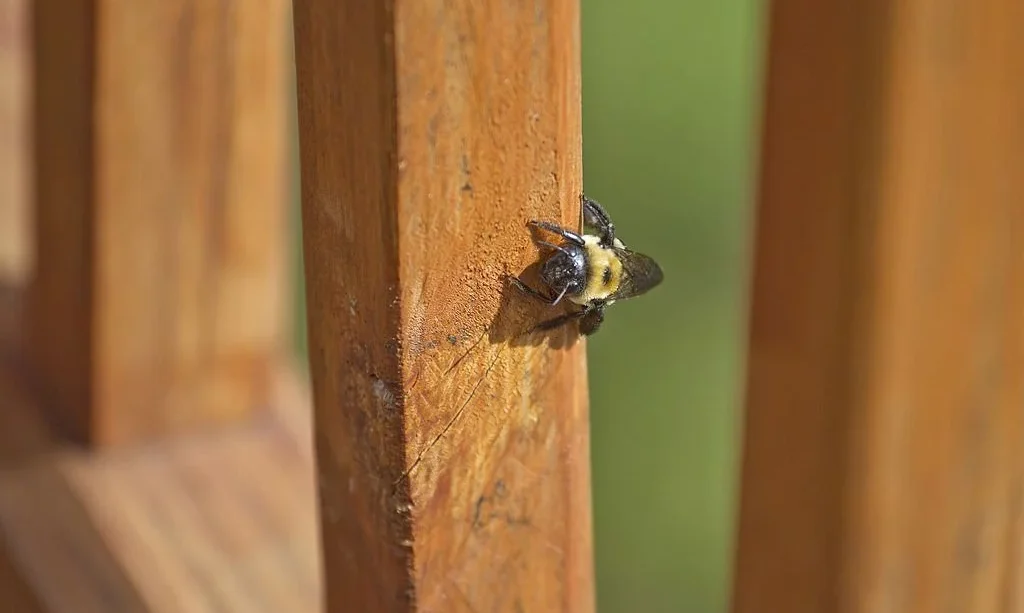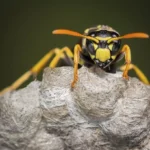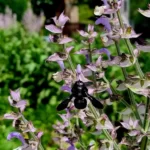Welcome to the world of carpenter bees! These fascinating insects are often seen buzzing around outdoor spaces, raising questions about their behavior and potential risks. In this article, we’ll explore carpenter bees and shed light on their characteristics and habits. Let’s dive in and learn more about these buzzing creatures!
Carpenter Bees
Carpenter bees are large, robust bees that are known for their resemblance to bumblebees. However, there are distinct differences between the two. Unlike bumblebees, carpenter bees have a shiny, hairless abdomen. They are solitary bees, meaning they don’t live in colonies like honeybees. Instead, each female carpenter bee builds her own nest.
Male carpenter bees can be quite intimidating as they fly around, often in search of mates. They may approach humans out of curiosity, but they are actually harmless and incapable of stinging. Female carpenter bees, on the other hand, do have stingers and can sting if they feel threatened or provoked.
Carpenter bees get their name from their nesting habits. They excavate tunnels in wood, such as trees, wooden structures, or even wooden furniture. These tunnels serve as their nests, where they lay eggs and raise their offspring. Over time, these tunnels can cause damage to the wood, but the extent of the damage is typically minimal and rarely poses a structural threat.
It’s important to note that carpenter bees play an essential role in pollination. They visit flowers to collect nectar and pollen, aiding in the reproduction of many plant species. So, while they may appear intimidating at times, carpenter bees are important contributors to our natural ecosystems.
In the next sections, we’ll address common questions regarding carpenter bee behavior, including their stinging capabilities, and provide tips on how to coexist with these beneficial insects. So, let’s explore the world of carpenter bees and gain a deeper understanding of their role in nature!
Carpenter Bee Sting or Bite: The Truth
Let’s set the record straight about carpenter bees and their ability to sting or bite. Here’s what you need to know:
Contrary to popular belief, carpenter bees have the ability to sting, not bite. Female carpenter bees are equipped with stingers, while male carpenter bees, despite their aggressive appearance, are harmless and incapable of stinging.
Carpenter bees are generally peaceful and docile creatures that prefer to go about their business without bothering humans. They are more interested in gathering nectar and pollen from flowers than engaging in defensive behavior.
Carpenter Bee Stings: What to Expect
If you happen to encounter a female carpenter bee and she feels threatened or provoked, she may sting as a defense mechanism. However, carpenter bee stings are relatively rare and typically not aggressive. In fact, these bees are known for their non-aggressive nature compared to other stinging insects, such as wasps or hornets.
If you do get stung by a carpenter bee, the effects are usually mild. You may experience some pain, swelling, or redness around the sting site. However, allergic reactions to carpenter bee stings are rare, and most people can easily tolerate the discomfort with basic first aid measures.
To alleviate any discomfort from a carpenter bee sting, you can apply a cold compress or ice pack to the affected area to reduce swelling. Over-the-counter antihistamines or pain relievers can also help ease any discomfort. If you experience severe symptoms or have a known allergy to bee stings, it’s important to seek medical attention promptly.
Remember, the best way to avoid carpenter bee stings is to respect their space and avoid aggressive or threatening behavior towards them. Coexisting with these buzzing creatures is usually peaceful and harm-free.
Now that you have a better understanding of carpenter bee stings and what to expect, you can appreciate these important pollinators and their role in our ecosystem. Let’s move forward and explore ways to peacefully coexist with carpenter bees in our outdoor spaces!
Reducing the Risk of Carpenter Bee Stings
While carpenter bee stings are generally rare and mild, it’s always good to take precautions to minimize the risk of getting stung. Here are some tips to reduce the likelihood of carpenter bee stings:
- Stay Calm: Carpenter bees are generally non-aggressive and prefer to avoid confrontation. By remaining calm and composed, you reduce the chances of provoking them.
- Wear Protective Clothing: If you’re working near carpenter bee nesting areas or have known sensitivities to bee stings, consider wearing long sleeves, pants, and closed-toe shoes to minimize exposed skin.
- Avoid Rapid Movements: Sudden, quick movements can startle carpenter bees, increasing the likelihood of defensive behavior. Move slowly and avoid swatting or waving your hands around them.
- Seal Potential Nesting Sites: To prevent carpenter bees from establishing nests in wooden structures, seal any existing holes or cracks in outdoor wooden surfaces. Use caulk, putty, or wood fillers to block their access.
- Distract with Alternative Nectar Sources: Providing attractive flowering plants away from high-traffic areas can divert carpenter bees’ attention, reducing their interest in human-occupied spaces.
Carpenter Bee Bites: Debunking the Myth
There is a common misconception that carpenter bees bite humans. However, it’s important to clarify that carpenter bees lack biting mouthparts. Their primary focus is on collecting nectar and pollen from flowers using their specialized tongue-like structure called a proboscis. So, rest assured, carpenter bees do not bite humans.
Conclusion
By understanding the behavior and characteristics of carpenter bees, we can coexist peacefully with these important pollinators. While female carpenter bees can sting if threatened, their stings are generally mild, and they are not aggressive insects. Following simple precautions, such as staying calm, wearing protective clothing, and sealing potential nesting sites, can help reduce the risk of carpenter bee stings.
Remember, carpenter bees play a crucial role in pollination, contributing to the health and diversity of our natural environment. By respecting their space and appreciating their presence, we can foster a harmonious relationship with these buzzing creatures. So, next time you see a carpenter bee, take a moment to admire its beauty and the valuable work it does in our ecosystem.



